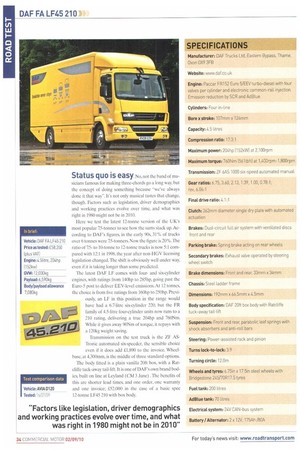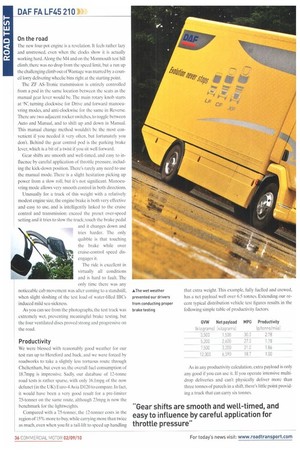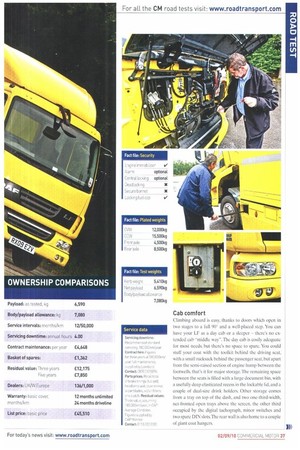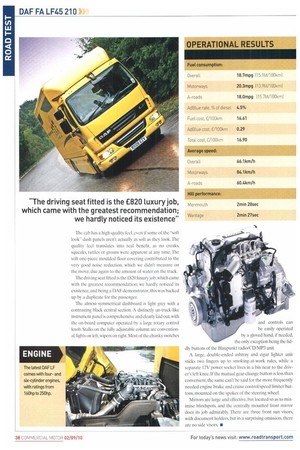Status quo is easy. No, not the band of musicians
Page 34

Page 36

Page 37

Page 38

If you've noticed an error in this article please click here to report it so we can fix it.
famous for making three-chords go a long way, but the concept of doing something because "we've always done it that way". It's not only musical tastes that change, though. Factors such as legislation, driver demographics and working practices evolve over time, and what was right in 1980 might not be in 2010.
Here we test the latest 12-tonne version of the UK's most popular 7.5-tonner to see how the sums stack up. According to DAF's figures, in the early 90s, 31% of trucks over 6 tonnes were 7.5-tonners. Now the figure is 20%.The ratio of 7.5to 10-tonne to 12-tonne trucks is now 5:1 compared with 12:1 in 1998, the year after non-HGV licensing legislation changed. The shift is obviously well under way, even if it is taking longer than some predicted.
The latest DAF LF comes with fourand six-cylinder engines, with ratings from 140hp to 285hp, going past the Euro-5 post to deliver EEV-level emissions. At 12 tonnes, the choice is from five ratings from 160hp to 250hp. Previously, an LF in this position in the range would have had a 6.7-litre six-cylinder 220, but the FR family of 4.5-litre four-cylinder units now runs to a 210 rating, delivering a true 204hp and 760Nrn. While it gives away 90Nm of torque, it repays with a 120kg weight saving.
Transmission on the test truck is the ZF ASTronic automated six-speeder, the sensible choice even if it does add 11,890 to the invoice. Wheelbase, at 4,300mm, is the middle of three standard options. The body fitted is a plain vanilla 20ft box, with a Ratcliffe tuck-away tail-lift. It is one of DAF's own brand bodies, built on line at Leyland (CM 3 June) . The benefits of this are shorter lead times, and one order, one warranty and one invoice: 152,000 in the case of a basic spec 12-tonne LF45 210 with box body. On the road
• The new four-pot engine is a revelation. It feels rather lazy and unstressed, even when the clocks show it is actually working hard. Along the M4 and on the Monmouth test hill climb, there was no drop from the speed limit, but a run up the challenging climb out of Wan tage was marred by a council lorry delivering wheelie bins right at the starting point.
The ZF AS-Tronic transmission is entirely controlled from a pod in the same location between the seats as the manual gear lever would be. The main rotary knob starts at 'N', turning clockwise for Drive and forward manoeuvring modes, and anti-clockwise for the same in Reverse. There are two adjacent rocker switches, to toggle between Auto and Manual, and to shift up and down in Manual. This manual change method wouldn't be the most convenient if you needed it very often, but fortunately you don't. Behind the gear control pod is the parking brake lever, which is a bit of a twist if you sit well forward.
Gear shifts are smooth and well-timed, and easy to influence by careful application of throttle pressure. including the kick-down position. There's rarely any need to use the manual mode. There is a slight hesitation picking up power from a slow roll, but it's not significant. Manoeuvring mode allows very smooth control in both directions.
Unusually for a truck of this weight with a relatively modest engine size, the engine brake is both very effective and easy to use, and is intelligently linked to the cruise control and transmission: exceed the preset over-speed setting and it tries to slow the truck; touch the brake pedal and it changes down and tries harder. The only quibble is that touching the brake while over cruise-control speed disengages it.
The ride is excellent in virtually all conditions and is hard to fault. The only time there was any noticeable cab movement was after coming to a standstill, when slight sloshing of the test load of water-filled IBCs induced mild sea-sickness.
As you can see from the photographs, the test track wa,; extremely wet, preventing meaningful brake testing, hut the four ventilated discs proved strong and progressive on the road.
Productivity
We were blessed with reasonably good weather for our test run up to Hereford and back, and we were forced by roadworks to take a slightly less tortuous route through Cheltenham, but even so, the overall fuel consumption of 18.7mpg is impressive. Sadly, our database of 12-tonne road tests is rather sparse, with only 16.1mpg of the now defunct (in the UK) Euro-4 Avia D120 to compare. In fact, it would have been a very good result for a pre-limiter 7.5-tonner on the same route, although 23mpg is now the benchmark for the lightweights.
Compared with a 7.5-tonner, the 1240i-trier costs in the region of 15% more to buy, while carrying more than twice as much, even when you fit a tail-lift to speed up handling
that extra weight. This example, fully fuelled and crewed, has a net payload well over 6.5 tonnes. Extending our recent typical distribution vehicle test figures results in the following simple table of productivity factors.
As in any productivity calculation, extra payload is only any good if you can use it. If you operate intensive multidrop deliveries and can't physically deliver more than three tonnes of parcels in a shift, there's little point providing a truck that can carry six tonnes.
Cab comfort Climbing aboard is easy, thanks to doors which open in two stages to a full 900 and a well-placed step. You can have your LF as a day cab or a sleeper there's no extended cab "middle way". The day cab is cosily adequate for most needs, but there's no space to spare. You could stuff your coat with the toolkit behind the driving seat, with a small rucksack behind the passenger seat, but apart from the semi-raised section of engine hump between the footwells, that's it for major storage. The remaining space between the seats is filled with a large document bin, with a usefully deep elasticated recess in the lockable lid, and a couple of dual-size drink holders. Other storage comes from a tray on top of the dash, and two one-third-width, net-fronted open trays above the screen. the other third occupied by the digital tachograph, minor switches and two spare DIN slots.The rear wall is also home to a couple of giant coat hangers. The cab has a high-quality feel, even if some of the -soft look" dash panels aren't actually as soft as they look. The quality feel translates into real benefit, as no creaks, squeaks, rattles or groans were apparent at any film. The soft one-piece moulded floor covering contributed to the very good noise reduction, which we didn't measure on the move, due again to the amount of water on the track.
The driving seat fitted is the £820 luxury job, which came with the greatest recommendation; we hardly noticed its existence, and being a DAF demonstrator, this was backed up by a duplicate for the passenger.
The almost symmetrical dashboard is light grey with a contrasting black central section. A distinctly un-truck-like instrument panel is comprehensive and clearly laid out, with the on-board computer operated by a large rotary control knob. Stalks on the fully adjustable column are conventional, lights on left, wipers on right. Most of the chunky switches and controls can be easily operated by a gloved hand, if needed, the only exception being the fiddly buttons of the Blaupunkt radio/CDIMP3 unit.
A large, double-ended ashtray and cigar lighter unit sticks two fingers up to smoking-at-work rules, while a separate 12V power socket lives in a bin near to the driver's left knee. If the manual gear-change button is less than convenient, the same can't be said for the more frequently needed engine brake and cruise control/speed limiter buttons, mounted on the spokes of the steering wheel.
Minors are large and effective, but located so as to minimise blindspots, and the centrally mounted front mirror does its job admirably. There are three front sun visors, with document holders, hut in a surprising omission, there are no side visors. •
























































































































































































































































